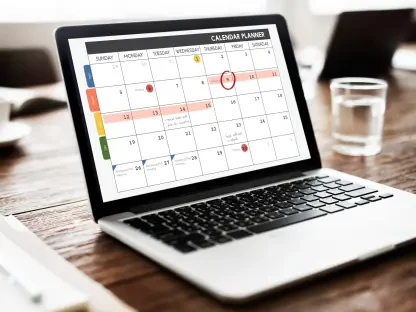In today’s digital landscape, standing out among countless businesses vying for attention is a formidable challenge, especially for B2B companies seeking to connect with decision-makers who hold the key to meaningful partnerships. Imagine a platform where over 79% of B2B marketers, according to a recent survey, consider it their top social media tool for reaching professional audiences. LinkedIn has emerged as that powerhouse, offering unparalleled opportunities for networking and brand exposure. This guide aims to unlock the potential of LinkedIn SEO, providing actionable strategies to elevate a business’s online presence and ensure it is discovered by the right audience, both within the platform and on external search engines like Google.
The importance of optimizing a LinkedIn presence cannot be overstated in a world where digital impressions often precede real-world interactions, and a strong online profile can make a significant impact. A well-crafted profile and strategic content plan can transform a company page from a mere placeholder into a magnet for leads, partnerships, and talent. This comprehensive guide will explore why LinkedIn SEO is a game-changer and offer step-by-step instructions to enhance visibility, helping businesses build authority and engagement among targeted professional communities.
By following the detailed tactics outlined in this resource, businesses can expect to see measurable improvements in profile views, connection requests, and overall brand recognition. The focus will be on practical, proven methods to align with LinkedIn’s algorithm while catering to user search intent. From profile completion to content creation, every aspect of LinkedIn SEO will be covered to ensure companies maximize their reach and impact in the competitive digital marketplace.
Unleashing the Power of LinkedIn SEO for Business Growth
LinkedIn has solidified its position as an indispensable tool for B2B marketers, with a significant 79% of professionals in this space ranking it as their primary social media platform for business development, according to a widely cited 2023 survey. This statistic underscores the platform’s unique ability to connect companies with industry leaders, potential clients, and top talent. By leveraging LinkedIn SEO, businesses can amplify their visibility not just within the platform’s ecosystem but also across broader search engine results, ensuring they are seen by a global audience searching for relevant services or expertise.
The transformative potential of LinkedIn SEO lies in its capacity to position a company as an industry authority while driving organic traffic. An optimized profile or piece of content can appear in search results for specific keywords, making it easier for prospective partners or customers to find and engage with the brand. This approach goes beyond mere presence, focusing on strategic discoverability that aligns with user intent and platform algorithms, setting the foundation for sustained growth.
This guide will dive into actionable strategies that promise tangible benefits, such as increased profile views, higher engagement rates, and stronger connections with niche audiences. From crafting compelling headlines to publishing long-form content indexed by external search engines, the upcoming sections will provide a roadmap for businesses to harness LinkedIn’s full potential. The focus will be on practical steps that can be implemented immediately to see real-world results in visibility and influence.
Why LinkedIn SEO Matters in the Digital Marketplace
In the ever-evolving digital arena, LinkedIn has transcended its original purpose as a job-seeking platform to become a vital hub for business networking and marketing. Companies now rely on this space to establish thought leadership, showcase expertise, and forge meaningful professional relationships. With millions of users actively seeking solutions and partnerships, a robust LinkedIn presence enhanced by SEO practices ensures that a business remains visible amidst the noise of countless competitors.
The broader impact of LinkedIn SEO extends to building brand authority and fostering audience engagement on a scale that few other platforms can match. When a company page or content ranks higher in search results, it not only attracts views but also instills trust among viewers who associate high visibility with credibility. This dynamic is particularly critical for B2B enterprises aiming to influence decision-makers who prioritize reliable and authoritative sources in their research and procurement processes.
Moreover, the competitive edge gained through LinkedIn SEO is invaluable in a crowded online environment where differentiation is key. By optimizing for specific search terms and maintaining an active, polished presence, businesses can capture the attention of targeted demographics more effectively than through generic marketing efforts. This strategic focus on discoverability positions companies to thrive by connecting with the right people at the right time, cementing LinkedIn’s role as a cornerstone of modern digital marketing strategies.
Mastering LinkedIn SEO: Key Strategies for Visibility
Optimizing a LinkedIn presence requires a methodical approach that aligns with both platform algorithms and user expectations. This section provides a detailed, step-by-step framework to enhance search rankings and attract the right audience, ensuring that businesses maximize their impact. Each strategy focuses on specific elements of LinkedIn SEO, from profile setup to content creation, offering practical insights for immediate application.
The importance of a comprehensive LinkedIn SEO plan lies in its ability to address multiple facets of visibility simultaneously, ensuring that businesses stand out in a crowded digital space. By integrating profile optimization with content strategies, companies can create a cohesive online identity that resonates with viewers and search mechanisms alike. The following steps break down essential tactics to build a powerful presence that drives engagement and connections.
Beyond individual tactics, the synergy of these strategies creates a cumulative effect, amplifying a business’s reach over time. Consistency in applying these methods, paired with regular updates to reflect industry trends, ensures sustained relevance. The guide below details each critical component, providing a clear path to mastering LinkedIn SEO for enhanced business visibility.
Step 1: Building a Complete and Polished Profile
A fully completed LinkedIn profile serves as the foundation for any successful SEO strategy on the platform, with data indicating that such profiles receive 30% more views compared to incomplete ones. This boost in visibility stems from LinkedIn’s preference for high-quality, detailed pages that provide users with comprehensive information. Businesses must prioritize filling out every section to signal credibility and relevance to both the algorithm and potential visitors.
Ensuring that all profile elements are meticulously crafted can significantly elevate a company’s online impression, making a strong impact on potential customers and partners. Key details such as a clear description, accurate categorization, and engaging visuals contribute to a professional appearance that invites interaction. This step is not merely about completion but about creating a compelling narrative that reflects the brand’s identity and value to its audience.
Attention to detail in this initial phase sets the tone for subsequent SEO efforts, making it easier to rank for relevant searches. A polished profile acts as a digital storefront, welcoming prospects and encouraging them to explore further. The following subsections outline specific components to focus on for maximum impact and discoverability.
Crafting a Professional Logo and Banner
A recognizable company logo and a visually striking banner image are essential for establishing brand identity on LinkedIn. These elements are often the first visual cues visitors notice, influencing their perception of professionalism and trustworthiness. LinkedIn recommends specific dimensions for optimal display: 300×300 pixels for logos and 1128×191 pixels for banners, ensuring clarity across devices.
Consistency in visual branding through these images helps reinforce recognition among users who may encounter the business in various contexts. A well-designed logo should be simple yet distinctive, while the banner can showcase the company’s mission or highlight key offerings through imagery or text. This visual alignment strengthens the overall profile appeal.
Investing time in creating or updating these graphics pays off by enhancing first impressions and encouraging profile visits. High-quality visuals not only attract attention but also convey a sense of attention to detail, which can differentiate a business from competitors with less polished profiles. This step is a critical starting point for building a memorable online presence.
Writing a Standout Overview and Headline
The overview section of a LinkedIn profile offers a prime opportunity to summarize a business’s unique value proposition in a concise, impactful manner. This narrative should articulate what sets the company apart, addressing the specific needs or challenges of its target audience. A compelling overview draws viewers in, encouraging them to learn more about the products or services offered.
Equally important is the headline or tagline, which should capture the essence of the company’s mission in a succinct phrase. This element appears prominently in search results and profile views, making it a powerful tool for grabbing attention. Crafting a headline that incorporates key themes or benefits ensures that it resonates with those scanning for relevant businesses.
Both sections must balance informativeness with engagement, avoiding overly technical jargon while still conveying expertise. Regularly revisiting and refining these descriptions to reflect current goals or achievements keeps the profile dynamic and relevant. This focus on clarity and appeal directly supports SEO by aligning with user search intent and interest.
Adding Key Organizational Details
Including essential organizational details such as industry, company size, and location is crucial for LinkedIn to categorize a business accurately within its search framework. These specifics help the platform match the profile with relevant user queries, increasing the likelihood of appearing in targeted searches. Accuracy in this data ensures that the right audience discovers the company.
Beyond aiding search functionality, these details provide transparency to visitors, building trust by offering a clear picture of the business’s scope and context. For instance, specifying an industry like “software development” or “financial services” narrows down the audience to those with aligned interests. This categorization is a subtle yet effective way to enhance relevance.
Regular updates to these fields, especially if there are changes in operations or expansion, help maintain the profile’s alignment with current business realities. Overlooking this step can lead to miscategorization, reducing visibility among the intended demographic. Thoroughness in completing these sections is a fundamental aspect of a robust LinkedIn SEO strategy.
Incorporating a Call-to-Action Button
Adding a call-to-action (CTA) button on a LinkedIn profile directs visitors to critical destinations such as a company website, contact page, or product landing page. This feature facilitates seamless navigation for users interested in taking the next step, whether that involves learning more about services or initiating direct communication. A well-placed CTA significantly enhances user engagement.
Selecting the appropriate CTA option—such as “Visit Website” or “Contact Us”—depends on the primary goal of the profile, whether it’s driving traffic or generating leads. LinkedIn allows customization of this button to align with specific business objectives, making it a versatile tool for conversion. This functionality bridges the gap between visibility and actionable outcomes.
Ensuring that the linked destination is optimized for user experience, such as a mobile-friendly website, maximizes the effectiveness of this feature. Regularly reviewing the performance of the CTA and adjusting it based on analytics or changing priorities keeps the profile aligned with marketing goals. This small but impactful addition can significantly boost interaction rates.
Step 2: Leveraging Keywords for Search Relevance
Strategic use of keywords is a cornerstone of LinkedIn SEO, aligning content with the platform’s algorithm and the search intent of users. Keywords act as signposts, guiding the right audience to a business page by matching their queries with relevant terms. However, overusing or forcing keywords—often termed keyword stuffing—can harm readability and reduce search performance, so a balanced approach is essential.
Identifying and integrating terms that reflect the business’s core offerings or industry focus requires thoughtful research and application. These keywords should resonate with what potential clients or partners might search for, ensuring the profile appears in relevant results. This practice not only boosts visibility but also positions the company as a pertinent solution provider within specific niches.
The following subsections provide guidance on discovering valuable keywords and placing them effectively within a profile. By prioritizing natural integration over excessive repetition, businesses can maintain a professional tone while optimizing for search. This dual focus on relevance and authenticity is key to achieving sustained SEO success on LinkedIn.
Finding Keywords with LinkedIn Search Suggest
LinkedIn’s search bar offers a powerful tool called Search Suggest, which displays dropdown suggestions as users type in queries, reflecting real search behaviors. Businesses can use this feature by entering basic terms related to their industry or services and noting the suggested phrases that appear. These insights reveal what terms are commonly searched, providing a direct line to audience intent.
Analyzing these suggestions helps uncover keywords that might not have been initially considered, broadening the scope of optimization. For instance, a marketing agency might start with “digital marketing” and discover related terms like “digital marketing for small businesses” or “digital marketing trends.” This method ensures alignment with actual user needs rather than assumptions.
Regularly revisiting this tool to track evolving search patterns keeps the keyword strategy current and effective, ensuring that businesses stay aligned with changing trends. Incorporating these terms into various profile elements or content pieces enhances discoverability without requiring complex external tools. This accessible approach democratizes SEO research, making it actionable for businesses of any size.
Placing Keywords in High-Impact Areas
Once relevant keywords are identified, their placement in high-impact areas such as headlines, taglines, and the top portions of descriptions is critical for SEO effectiveness. These sections are prioritized by LinkedIn’s algorithm and are often the first content users see, making them prime real estate for optimization. Strategic placement here maximizes the chances of ranking for targeted searches.
However, integration must feel organic to avoid disrupting the flow of text or alienating readers with awkward phrasing. For instance, a headline might naturally include a term like “Innovative Tech Solutions Provider” rather than a forced list of keywords. This balance ensures the profile remains engaging while still catering to search mechanisms.
Reviewing and adjusting keyword usage periodically, especially in response to shifts in industry terminology or audience behavior, helps maintain relevance. Overloading any section with terms should be avoided, as it risks diminishing the professional tone of the profile. Thoughtful placement in these key areas drives visibility without sacrificing quality or user experience.
Step 3: Enhancing Visual Appeal with Quality Imagery
Visual elements play a pivotal role in LinkedIn SEO by boosting engagement and increasing profile views, with research showing that profiles featuring professional photos garner 14 times more views than those without. High-quality imagery not only captures attention but also conveys a sense of credibility and care, influencing how users perceive a business. This visual impact is a subtle yet powerful driver of interaction.
Beyond mere aesthetics, images contribute to brand storytelling, offering a glimpse into the company’s ethos or offerings at a glance. A cohesive visual strategy can differentiate a profile in a sea of competitors, making it memorable to visitors. Ensuring that these elements meet platform standards and align with branding is essential for maximizing their SEO benefit.
The subsections below detail specific guidelines for imagery and how to align it with brand identity. Adhering to the recommended specifications prevents issues like pixelation or poor formatting, while a consistent visual theme reinforces recognition. This focus on quality and coherence elevates a profile’s overall effectiveness in attracting the right audience.
Meeting LinkedIn’s Image Specifications
LinkedIn provides specific dimensions for images to ensure they display correctly across various devices and contexts. For business profiles, the company logo should be 300×300 pixels, while the banner image should measure 1128×191 pixels. For individual profiles, the profile picture requires 400×400 pixels, and the background photo should be 1584×396 pixels, supporting formats like JPG, PNG, and GIF.
Adhering to these guidelines prevents visual distortions that could undermine professionalism, such as blurry logos or cropped banners. Testing how images appear on both desktop and mobile interfaces guarantees a seamless user experience, as many users access LinkedIn via smartphones. This attention to technical detail enhances the profile’s polish and accessibility.
Regularly updating visuals to reflect current branding or campaigns, while maintaining these specifications, keeps the profile fresh and relevant. Overlooking these standards can result in a subpar presentation that deters potential connections. Precision in meeting these requirements is a straightforward yet impactful aspect of LinkedIn SEO.
Aligning Imagery with Brand Identity
Beyond technical specifications, imagery on LinkedIn should reflect a company’s brand identity, creating a consistent visual narrative that resonates with viewers. Whether through color schemes, logos, or thematic banners, these elements should mirror the business’s values, culture, or unique selling points. This alignment fosters instant recognition and emotional connection with the audience.
For instance, a tech startup might use modern, minimalist designs in its banner to convey innovation, while a sustainability-focused company could incorporate nature-inspired visuals. Such choices communicate the brand’s essence without words, leaving a lasting impression on profile visitors and enhancing memorability and differentiation through strategic use of visuals.
Periodically evaluating imagery to ensure it remains aligned with evolving brand goals or market positioning prevents outdated impressions and helps maintain relevance in a competitive landscape. Engaging a professional designer, if budget allows, can further refine this aspect, ensuring high-quality output. Consistent branding through visuals is a subtle but effective way to strengthen LinkedIn SEO outcomes.
Step 4: Driving Engagement with Relevant Content
Posting relevant content on LinkedIn is a dynamic way to signal value to the platform’s algorithm, as engagement metrics like likes, comments, and shares directly influence search authority. Active profiles that consistently share meaningful updates are prioritized in search results, as they indicate ongoing relevance to users. This activity transforms a static page into a lively hub of interaction.
Content that resonates with an audience not only boosts visibility but also fosters community, encouraging followers to return for insights or updates. Tailoring posts to address industry challenges, share success stories, or provide actionable tips ensures they strike a chord with viewers. This relevance is a key driver of sustained engagement and profile growth.
The subsections below explore specific approaches to crafting content that targets niche groups and delivers value. By focusing on audience needs and platform best practices, businesses can create a content strategy that enhances SEO while building meaningful connections. This dual purpose makes content a cornerstone of LinkedIn optimization.
Targeting Niche Audiences with Tailored Posts
Using long-tail keywords in posts can effectively target niche audiences by addressing specific interests or pain points. For example, a social media agency might post about “social media marketing for beauty brands” to attract a particular segment rather than a broad audience. Such specificity ensures the content reaches those most likely to engage or convert.
Tailoring posts to reflect the unique needs of a demographic or industry also builds relevance, making the business appear as a go-to resource for specialized solutions. This approach requires understanding the audience’s search habits and content preferences, often gleaned through analytics or feedback. Precision in targeting amplifies the impact of each update.
Regularly experimenting with different long-tail phrases and monitoring engagement metrics helps refine this strategy over time. Adjusting content based on what resonates most keeps the profile aligned with audience expectations. This focused content creation is a powerful tool for enhancing visibility among specific professional circles.
Crafting Value-Driven Content
Creating posts that align with audience values, such as sustainability or innovation, fosters deeper connections by appealing to shared beliefs or goals. For instance, a company emphasizing eco-friendly practices might share insights on green initiatives, resonating with environmentally conscious professionals. This alignment builds loyalty and encourages interaction.
Value-driven content should prioritize providing solutions or inspiration over overt promotion, positioning the business as a helpful thought leader rather than a sales-driven entity. Sharing case studies, tips, or industry news with a unique perspective adds substance to posts, increasing their shareability. This approach enhances engagement, a key factor in LinkedIn’s ranking system.
Consistency in delivering such content, paired with responsiveness to comments or messages, further strengthens audience relationships. Analyzing which themes generate the most interaction allows for continuous improvement of the content mix. Crafting posts with genuine value at their core elevates a profile’s standing and SEO performance.
Step 5: Expanding Reach with LinkedIn Articles
Publishing long-form articles on LinkedIn offers a significant opportunity to increase visibility, as these pieces are indexed by Google, extending reach beyond the platform’s boundaries. Unlike regular posts, articles allow for in-depth exploration of topics, establishing a business as an authority in its field. This broader exposure can attract audiences who might not otherwise encounter the profile.
Articles also benefit from LinkedIn’s built-in SEO tools, enabling customization that enhances discoverability on external search engines. This dual-platform visibility makes them a powerful tool for driving traffic and building brand recognition over time. Businesses can leverage this format to showcase expertise on a scale that shorter updates cannot match.
The subsections below detail how to optimize these articles and select topics for maximum appeal. By focusing on strategic content creation and SEO practices, companies can ensure their articles reach a wide yet relevant audience. This approach amplifies LinkedIn SEO efforts with a lasting impact.
Optimizing Articles with SEO Tools
LinkedIn provides features like custom SEO titles and meta descriptions within its article editor, allowing businesses to tailor how content appears in search engine results. These tools help Google and other engines understand the article’s focus, improving its chances of ranking for relevant queries. Proper use of these features can significantly enhance visibility and engagement with the target audience.









